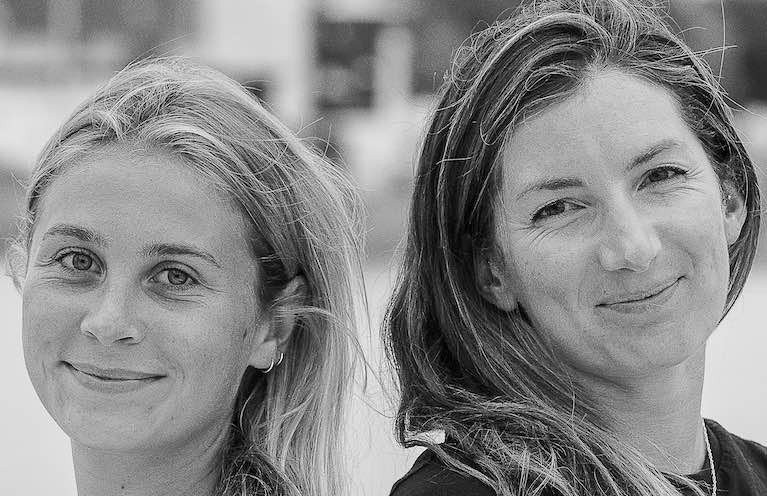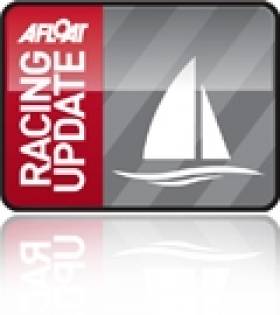Displaying items by tag: doublehanded
The World Speed Sailing Record Council Council (WSSR) has announced the establishment of a new World Sailing Record established by Pamela Lee and Catherine Hunt for the 'Around Ireland doublehanded Outright World Record'.
Ireland's World Speed Sailing Commissioner Chris Moore made the announcement this afternoon following the ratification of the elapsed record time by the WSSR of 3 days 19 hours 41 minutes and 39 seconds.
As regular Afloat readers will know, the pair set the record last month from 13th to the 17th October 2020.
The official details that have earned the pair an Afloat Sailor of the Month Award are:
- Yacht: “R L Sailing” Beneteau Figaro 3.
- Start time: 06; 47; 15 GMT on the 13/10/20
- Finish time: 02;28;54 GMT on the 17/10/20
- Elapsed time: 3 days 19 hours 41 minutes and 39 seconds
- Course length: 698 NM
- Average speed: 7.61 kts
The benchmark time was set in the 2004 Round Ireland Race by Yannick Lemonnier and Aodhan Fitzgerald in 4 days 6 hours.
Last month's attempt by Lee and Hunt also established the initial Around Ireland Record for Women.
Winners Decided at IRC Double Handed National Championship
Organised by the Royal Southampton YC, in conjunction with the Royal Ocean Racing Club, the second edition of the IRC Double Handed National Championship took place in the Solent, last weekend. 37 teams took part racing in three IRC Classes, lack of wind on the Saturday was the undoing of the passage race but two excellent races were held on the first day in the Central Solent.
Race Director Robert Lamb, sets the scene for the championship. “With high pressure dominating the south coast of England racing was delayed on Friday until a south westerly settled in after 4pm. Two races were then run: a laid marks 'sausage triangle’ followed by a round the cans race. Wind eventually strengthened to 10-12 knots to provide good racing. Saturday was disappointing with not enough wind to run the scheduled three hour passage race. So two races only were completed for the championship. All competitors were invited to the RORC Cowes Clubhouse for supper, which had a terrific atmosphere.”
IRC ONE
Won by Neil Martin's Sunfast 3600, Hot Cookie with Phil Barnes as crew. Runner up was Tim Octon's Corby 35 Njos, crewed by Rob Larke and third was Rob Craigie's Sunfast 3600, Bellino, crewed by Deb Fish. Hot Cookie won both of the races held and Neil Martin and Phil Barnes have been racing together for about ten years.
“Both Phil and I come from a dinghy background and we still race in dinghy events. We started sailing two handed together in my J/133 about nine years ago and the main reason for the change was that it is a lot of fun and we have lots more jobs to do! The J/133 was great offshore but we wanted about we could sail well inshore, so we initially sailed a J/97, then moved on to the Sunfast 3600, which is really set up for two handed sailing.
The important factors in coming out on top in the National Championship were teamwork and experience. We have been racing two handed together for a long time, we both know what to do in most situations and when things go wrong, we have a better chance of sorting them out. Having sailed a bigger boat previously, the sail handling is easier on a smaller boat. We have been sailing in the Solent now for about 10 yrs and we are beginning to get to know our way around.”
Phil Barnes was quick to point out that starting well was a key ingredient to winning inshore. “Neil typically gets a very good start, which in the short races gave us a big advantage being clear to implement our race strategy. Of all the racing I do, double handed yacht racing on short courses is a huge physical and mental challenge and the most rewarding sailing I have ever done.”
IRC TWO
The largest class racing at the IRC Double Handed National Championship had 15 yachts vying for the class and five yachts took podium positions. Race One was won by the defending champion, Paul Griffith's J/109, Jagerbomb, crewed by his son Mark. William Gough's J/109, Just So, crewed by Christian Jeffries was second and William Newton's J/105, Jelly Baby, crewed by Bill Darley was third. The winner of Race Two was Andrew Roberts' J/105, Jin Tonic, crewed by Bill Edgerley. Second was Mike Moxley's HOD 35, Malice, crewed by Huw Phillips and third was David Franks' JPK 10.10, Strait Dealer, crewed by Graham Sunderland. Jin Tonic's was the class champion by a single point from Jagerbomb with Strait Dealer taking third on countback from Jelly Baby.
“The Royal Lymington Yacht Club organised a series of double handed races back in 2011, and we decided to give it a go and much to my surprise I enjoyed the challenge of adapting a boat that is normally raced with a crew of 7 to one that 2 can handle.” commented Andy Roberts, skipper of Jin Tonic. “I quickly learnt that every manoeuvre took more time and more effort and they should be kept to a minimum.
Racing short handed means you are utterly dependent on your partner, their skills and input both tactical and navigational, as well as the sail handling. The boat needs to be prepared differently, simplify everything, so there was no umming and arring about sail calls, we just use what we have got, remembering that not having an extra 450 kilos of crew weight on the rail meant that the boat was tuned differently so that we could de-power much earlier than usual to keep the boat on it's feet and footing rather than crabbing sideways.
I think one of the things that helped us get a good result was having a clear strategy on the route we were going to take around the course so that we had no last minute panic moves to make, for example, dropping the spinnaker on the correct side for the next hoist. Spinning the kit when going upwind is seriously slow, losing at least half a knot of boat speed for 5 or 10 minutes.
We did not chose a J/105 for any other reason than there were three others in Lymington, yet we have found it to be a super boat for both short handed and fully crewed racing; easy to handle and always feels safe even when surfing along at 14 knots.
To summarise we felt we did well by keeping it simple, so we had time to focus on the race.A big thank you to everyone at the Royal Southampton YC, for all their hard work to give us such an enjoyable regatta.”
IRC THREE
Congratulations to Paul Dunstan and crew Tony Wrath, winners of Race One and runners up in Race Two, winning their class for the IRC Double Handed National Championship, racing Folkboat, Mandarin. Chris Charlesworth's Contessa 26 Meow, crewed by Martin Young, scored a third and a bullet to finish runner up by just a point. Dave Wright's H-Boat, Hubble Bubble crewed by Luke Bradley was third just a point ahead of David & Peter Cowell's Hanse 291, Seahorse.
The third edition of the IRC Double Handed National Championship will be organised by the Royal Southampton YC, in conjunction with the Royal Ocean Racing Club, held in the Solent in 2016, late summer or early autumn – watch this space.
Irish Offshore Sailor Andrew Baker Heads for IRC Double Handed National Championship
Northern Ireland's Solitaire du Figaro sailor, Andrew Baker, will be racing with Solo Round the World Sailor, Mike Golding in RORC's second edition of the IRC Double Handed National Championship will take place in the Solent, this weekend.
A huge variety of keelboats have entered with about 40 teams taking part. Three races are scheduled with no discard. The variety of courses are designed to test all the elements of Double Handed racing with a laid marks course, a round the cans race and a long passage race.
Last year's IRC Class 1winner, Paul Griffiths' J/109 Jagerbomb will be defending their title and Paul will be once again be sailing with his son Mark. Jagerbomb has been competing in the Two Handed class for this year's RORC Season's Points Championship, including the Rolex Fastnet Race.
“I am sure that we will be making more tacks and gybes this weekend than we did for the whole of the Fastnet.” commented Paul Griffiths. “Full on – would be an apt description, especially with the two races on Friday. Racing Double Handed on a short course is very different to offshore. You don't have the time and the space and you are trying to make manoeuvres that you would normally do with nine people not two, which is just crazy but the secret is to avoid getting into problems and to do that you have to be thinking ahead all the time. Looking at this year's entry list there are some top class sailors and this year we have a group of Figaro II's from the Artemis Offshore Academy, which we didn't have last year.”
Artemis Ocean Racing have entered four double handed teams racing Figaro II skippered by talented young aspiring short handed sailors. RYA Match racer and 49er FX sailor Mary Rook. Will Harris, University Student and past Laser 4.7 National Champion. Hugh Brayshaw, Silver medallist at the 470 Junior European Championship. Andrew Baker, Solitaire du Figaro sailor, will be racing with Solo Round the world sailor, Mike Golding.
“There is some real talent and that is why the Artemis Academy is very interesting to me, it is the direct opposite to the opportunities that were available to me when I started racing.” commented Mike Golding. “ Racing on a short course, you are both involved in sailing the boat, all the time, so the biggest thing about this weekend will be knowing where you are going and to get there as cleanly as possible. You don't have the time to go down below and navigate, you have to know the marks of the course in advance and think ahead to the sail set up you will need – you have to mind-map the sequence of events. Figaros are not optmised for IRC, so our first goal will be to beat the other Figaros, but with plenty of corners, if we are slick around them, we might do well overall. It is a pleasure to be involved this weekend, I am an honoury member of the Royal Southampton and the club has always been there supporting me in my projects. The Royal Southampton has been running short handed racing for a long time. Teaming up with the RORC, as an IRC event for the Double Handed series and running the National Championship, has really opened it up to a large number of entries, which is fantastic.”
#rdirl – A father and son duo from Listowel in County Kerry are taking on the double-handed challenge in this year's Round Ireland Yacht Race. The pair Derek Dillon and son Conor, a 19–year–old Univesity of Limerick student, will race the family Dehler 34 'Big Deal' that is based on the Shannon Estuary.
The Foynes Yacht Club pairing have been racing together inshore for over ten years, and have competed at numerous ICRA's, Cork Weeks and Calves Weeks. The pair are sponsored by leading marine supplier, Union Chandlery.
They recently made the move into offshore racing, enjoying recent success in multiple ISORA Qualifying races.
'We look forward to the competitive adventure associated with doing such an endurance race, double- handed', father Derek told Afloat.ie
The pair also plan to compete in the Volvo Cork Week double-handed and compete fully-crewed in Cork Dry Gin Calves Week, in which they have finished first in class in the past two consecutive years.
All Round Fastnet in Normandy Channel Race
Having tacked down the southern seaboard of Ireland after rounding Tuskar Rock, all boats in the Normandy Channel Race have now rounded the Fastnet and are heading east on the homeward leg. The Normandy Channel Race is one of many that visit Irish waters without stopping, with the Mini Fastnet and others dipping into our territory to find a high-profile rock before fleeing again.
The 8 competitors are making for the Scilly Isles, a string of rocks scattered about the South-West tip of England. To the great delight of these sailors, the fog, which has been tenaciously clinging onto them for the past three days, is gradually dissipating the further South the Class 40s sail. However, little else has changed and they’re still canted over against the wind as they make headway towards the English Channel and Normandy.
Double-handers head for Tuskar
A fleet of top-class double-handers will streak across Ireland's south coast in the next two days as part of a 1,000-mile race beginning and ending in the French port of Caen. The Normandy Race sends the crews of Class 40s around the Tuskar rock and then on to round the Fastnet to Port before heading back toward France. The fleet has already navigated through the Solent, and in second position is a team including Michael Kleinjans, who set the Round Ireland single-handed record in his Class 40, Roaring 40.
The race can be followed online with the real-time tracker.































































